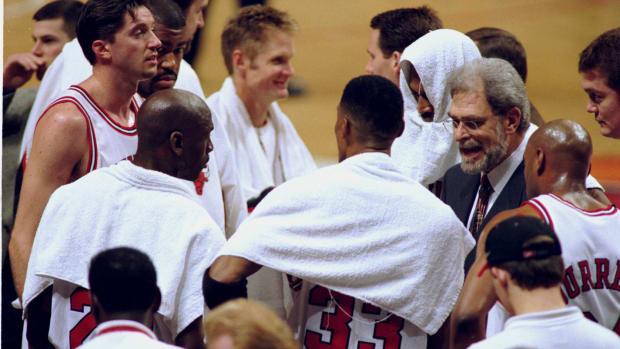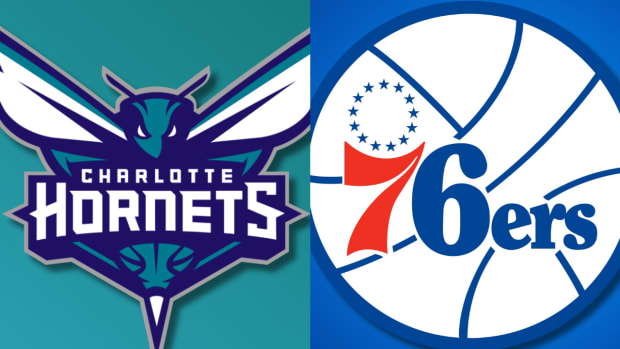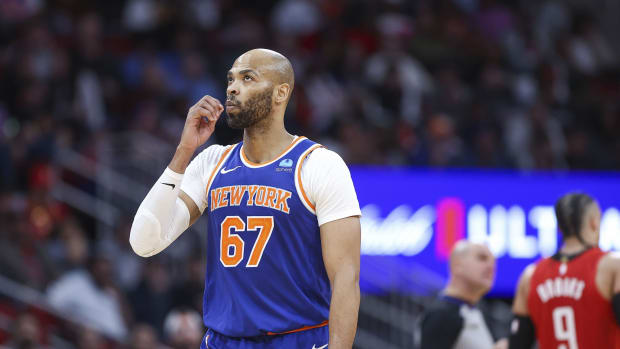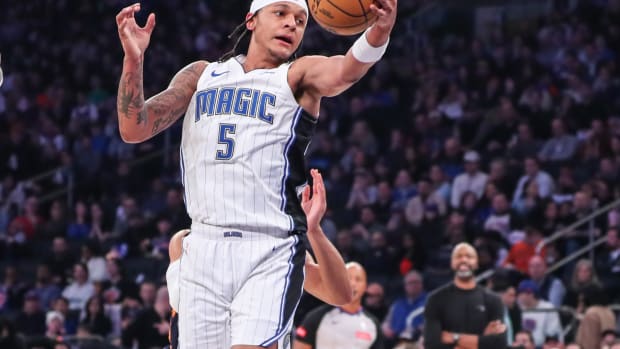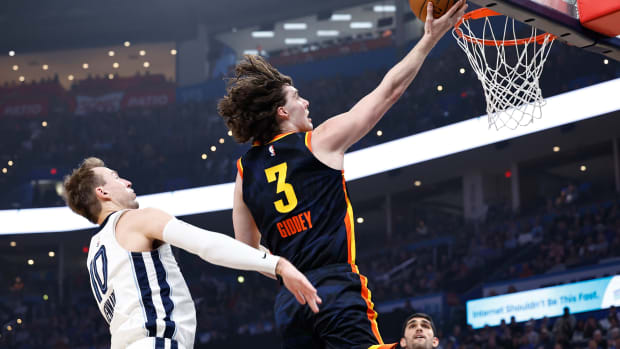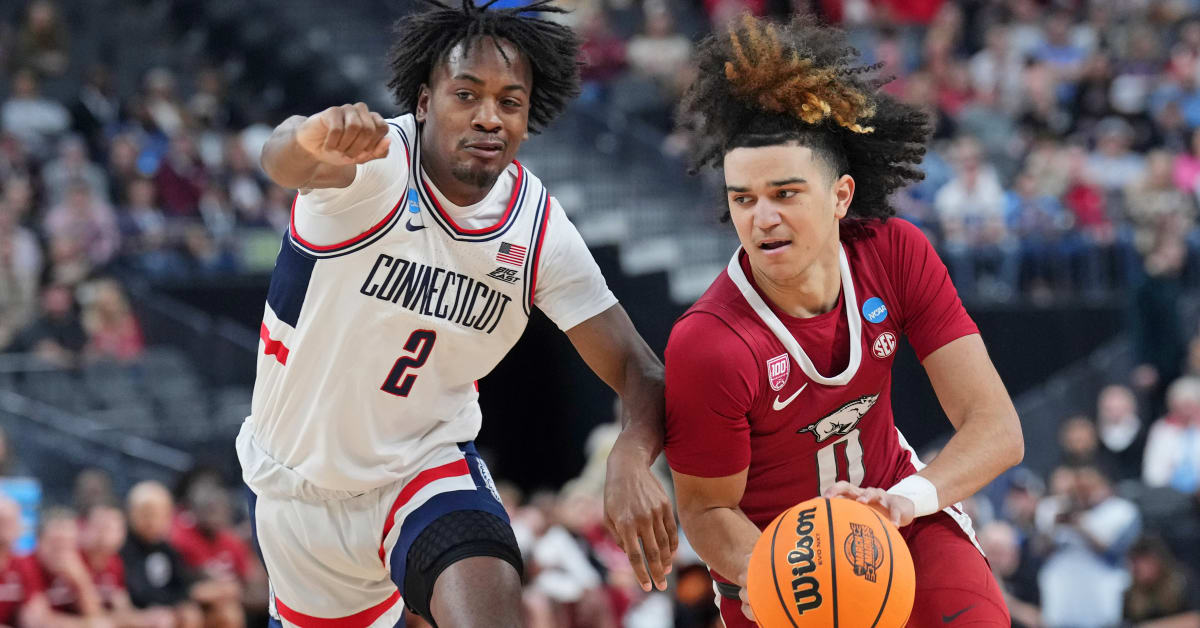
The Top 50 Prospects of the 2023 NBA Draft
The NBA draft is less than two months away. Much of the focus is at the top of the draft, where teams resorted to mass tanking measures to up their chances of winning the lottery and the chance to select French sensation Victor Wembanyama. But with key milestones in the draft calendar like the NCAA tournament and Portsmouth Invitational already in the books and the NBA draft combine fast approaching, it’s a good time to check in on how I’ve ranked the top prospects in this class.
A big board is based on my own opinions of the prospects from my work scouting these players in high school, college and the professional ranks. It is not a predictor of how NBA teams will draft, nor would it perfectly tail a team’s board given squads have to factor in how a player fits into their respective timeline. With that in mind, here’s a look at my top 50 players in this year’s draft.
1. Victor Wembanyama, Metropolitans 92 (France)
Wembanyama is the consensus No. 1 choice atop this draft for a reason. He possesses a skill set unlike any we’ve seen before for a player his size, dazzling scouts with his fluidity, shooting mechanics and ball skills despite towering over most defenders thanks to his 7’4” frame. And defensively, his massive wingspan allows him to impact the game in ways very few others can. He also has received rave reviews for his toughness, competitiveness and makeup. There will be no drama at the top of this draft: Whoever gets the No. 1 pick in this month’s lottery will select Wembanyama and begin building its team around him.
2. Scoot Henderson, G League Ignite
There has been increasing debate around whether Henderson or Alabama wing Brandon Miller is the best non-Wembanyama prospect in the class. While Miller seems to have built some momentum off a big season at Alabama, Henderson is still the better prospect in my eyes. Henderson had an uneven second year with G League Ignite, dealing with a concussion that caused him to miss time, and occasionally, struggling with turnovers and inefficiency. Still, his upside as a potential primary ballhandler is enormous, and it’s worth remembering he played much of this G League season as an 18-year-old against professionals.
3.Brandon Miller, Alabama
Miller had a poor NCAA tournament but still established himself as an elite prospect throughout a sparkling freshman campaign at Alabama. That season was marred by off-court controversy due to his connection to the shooting death of Jamea Jonae Harris that left fellow Crimson Tide player Darius Miles in jail on murder charges. Provided NBA teams are comfortable with Miller off the court following that incident, he’s worth a top-5 pick given his size and shooting ability, despite being old for a freshman. His floor is rather high as a big wing shooter, and there’s some upside to tap into here given the playmaking flashes he showed off at Alabama.
4. Jarace Walker, Houston
Walker showed glimmers of brilliance in an impressive freshman season at Houston, and his game fits well in the modern NBA. He’s a sturdy forward with a chiseled frame who profiles as a multipositional defender with a versatile skill set offensively. He made 35% of his threes (heavily of the catch-and-shoot variety) and also showed off a floater that could develop into a valuable shot in his arsenal. He’s not likely to be a guy that shoulders a huge load offensively, but Walker seems like a ready-made high-level role player if nothing else and fits into an archetype NBA teams covet.
5. Amen Thompson, Overtime Elite
It’s not hard to see the upside in drafting a 6’7” elite athlete with legitimate point guard skills and hoping to mold that into a potential star. But with those world-class physical tools also comes a lack of truly competitive basketball reps, given Thompson has spent the past two years in the Overtime Elite program rather than college or a more traditional professional setting. Thompson acquitted himself well in events like last summer’s The Basketball Tournament and a foreign tour against overseas pro teams, but how he’ll respond to real structure and the rigors of an NBA schedule are open questions.
6. Anthony Black, Arkansas
Black had a successful season at Arkansas despite the challenging context of near-constant injuries around him and poor floor spacing to maximize his skill set. He’s a cerebral player, one of the best passers in the draft and also a high-level defender, both on and off the ball. He’s still developing as a finisher and may never be a high-level scoring option, but he shouldn’t be a liability offensively thanks to his ability to cut, share the ball and make good decisions. The success of bigger, intelligent guards who can impact the game with or without the ball like Tyrese Haliburton and Josh Giddey helps boost this ranking.

Anthony Black will hope to translate a successful career at Arkansas to the pros.
Joe Camporeale/USA TODAY Sports
7. Taylor Hendricks, UCF
Hendricks was one of the bigger misses by the recruiting rankings world this year, going from outside the top 50 of the 247Sports composite to a potential lottery pick in a year’s time. Hendricks was somewhat out of the spotlight at UCF but was productive, averaging 15 points and 7 rebounds on impressive shooting splits for a team that made the NIT. It’s unclear whether he’ll develop into a player who can consistently be put on the ball like many of the big wings who blossom into all-stars, but I’ll take my chances on a plus athlete who shot 39% from three at 6’9” and is still just 19 years old.
8. Cam Whitmore, Villanova
Whitmore’s lone season at Villanova was an inconsistent one. He missed time early on due to a thumb injury, then seemed to struggle to find his rhythm on a Wildcats team that fell well short of expectations. Still, Whitmore is a powerful athlete who at times looks the part of a potential high-end scorer in the NBA, with the ability to drive and finish through contact and a developing handle that allows him to create space. He’s not a great shooter, but there’s room for growth there, and the shot is by no means broken. He’s still worth a top-10 pick, and jumping into the top five isn’t out of the question.
9. Ausar Thompson, Overtime Elite
Ausar is much more of a wing than his brother Amen, but many of the same positives and negatives addressed above with Amen Thompson apply to Ausar Thompson. He’s an elite athlete, and his shooting stroke has clearly improved since he first entered the NBA radar, but there’s no guarantee he’ll develop into a consistent weapon from beyond the arc. It may be a long process to get to the point where Ausar is contributing to winning at a high level given his lack of high-end competitive reps, though he may have a clearer path to being a useful role player than Amen as a plus defender and connective piece offensively.
10. Cason Wallace, Kentucky
There’s very little bust potential with Wallace, who may lack a bit of burst offensively but makes up for that by being an elite defender, a steady-handed playmaker and a high-level competitor. Performances like his eight-steal night against Michigan State at the heavily scouted Champions Classic set the tone, and he acquitted himself well even in varying roles as the Wildcats tried to balance Wallace and Sahvir Wheeler together in the backcourt. NBA spacing should help him offensively, particularly given how many poor shooters he was surrounded by in Lexington.
11. Gradey Dick, Kansas
Dick has a strong argument for being the best shooter in this draft, but there’s more to the Kansas product’s game than just his ability to stretch the defense. He has the requisite size and length to be a somewhat versatile defender, he consistently makes good decisions and is a smart mover without the basketball. Bill Self rarely shied away from giving Dick the ball in key moments to take and make clutch shots. I’d be surprised if he fell out of the lottery.
12. Jordan Hawkins, UConn
One of the stars of the NCAA tournament, Hawkins’s prototypical shooting stroke and ability to make threes off movement has earned him a chance to go in the lottery next month. Watching Hawkins’s near-constant motion running off screen after screen, then making shots in tight windows of space was impressive throughout the Huskies’ run to the national championship. The question is whether there’s another NBA-level skill he’ll develop. Right now, he’s likely to struggle defensively and isn’t strong enough to blossom into a true scorer at the next level.
13. Keyonte George, Baylor
George put up impressive counting stats at Baylor, but the film itself was far more uneven. The talent is obvious, and George clearly has a deep scoring back thanks to his touch and handle. But he also needs the ball in his hands to be successful, isn’t an efficient player and his decision-making and body language were poor at times during his lone season in Waco. George is a lottery-level talent, but sliding down later into the first round wouldn’t be a surprise.
14. Nick Smith, Arkansas
Smith entered the season perceived as perhaps the best NBA prospect in college basketball, but was plagued by knee injuries that caused him to miss significant time. Even when he was out there, he didn’t quite look like the player that earned such high acclaim from scouts late in his high school career. There’s some legitimate shotmaking upside if Smith can get healthy and regain that old form, but it will be hard for some NBA teams to forget his shaky year in Fayetteville.
15. Noah Clowney, Alabama
Clowney quickly emerged onto draft radars as a potential one-and-done at the PK85 event in Portland last November. He’s far from a finished product and may not be ready to truly add value to an NBA team on Day 1, but the potential here is enormous given his size, fluidity and smarts. He should be able to protect the rim in the NBA while also having the mobility to switch onto guards. If you buy his three-point shooting (28% this season) long term, he’s a very impressive prospect.
16. Dariq Whitehead, Duke
Like with Smith, Whitehead was a top prospect entering the college season who never really found his stride due to multiple injuries, including a broken foot in October. It’s important to remember NBA teams’ evaluations go well beyond college now, particularly with the availability of high school and AAU film. Whitehead played for prep powerhouse Montverde Academy and showcased interesting playmaking tools considering his big wing frame.
17. Kris Murray, Iowa
Murray isn’t the prospect his twin brother, Keegan, was, but still belongs in the first-round conversation. He had a productive season as Iowa’s top option, averaging 20 points and 8 rebounds per game in the NCAA tournament. Kris Murray won’t bring the immediate elite shooting that Keegan Murray brought to the Kings, but he is a solid outside shooter and generally impacts winning without needing many plays called for him.
18. Kobe Bufkin, Michigan
Bufkin’s stock soared in the second half of the season as he finally found the form that earned him McDonald’s All-American honors in high school. While a little undersized, Bufkin’s overall impact on the game pops on film. He’s improving as a ballhandler, shot 37% from three in Big Ten play and competes defensively. Plus, Bufkin won’t turn 20 years old until September, which makes him younger than several freshmen in this draft.
19. Jett Howard, Michigan
The size, shooting ability and emerging handle possessed by Howard makes him an impressive prospect. Plus, Howard’s father, Juwan, was a longtime NBA player before going on to coach Jett at Michigan. That said, Howard slipped some in my eyes late in the season with poor defense and several baffling mental mistakes. Those could both improve, but it was hard to be impressed with Jett Howard’s body language and effort down the stretch for a disappointing Michigan team.
20. Jalen Hood-Schifino, Indiana
I’m torn on how to evaluate Hood-Schifino as an NBA prospect. There are plenty of pros: above-average positional size, solid defensive instincts and an advanced midrange game. At the same time, Hood-Schifino lacks the burst to create separation from defenders and isn’t necessarily a primary ballhandler in the NBA. As long as he shoots it well, he’ll have a long career and might be worthy of a lottery pick. But there’s also some real downside here that caused me to move him down to the late teens.
21. Rayan Rupert, New Zealand Breakers
The latest NBL player to rise NBA boards, Rupert’s 7’3” wingspan and emerging skill set make him an intriguing prospect. He has been a part of winning with the New Zealand Breakers, and his low-maintenance game as a connector and defender has fit competitive basketball better than previous developing prospects in Australia. If you buy his three-point shot despite shaky percentages with the Breakers, this could be a worthwhile investment.
22. Dereck Lively II, Duke
Lively’s appeal as a prospect has always been his defense since his big summer of 2021 with Team Final on the EYBL circuit that vaulted him toward the top of recruiting rankings. Still, the production (or lack thereof) at Duke speaks for itself, and Lively simply wasn’t that impactful this year for prolonged stretches. There were moments, like his 10 blocks against North Carolina in February, but he’ll need to string together consistent performances to be a productive pro.
23. Colby Jones, Xavier
It’s hard to poke holes in Jones’s game after developing into one of the better two-way players in college basketball in his three years at Xavier. He’s unlikely to wow you, but I feel confident his ability to make shots, share the ball and defend will translate to making a positive impact for an NBA team sooner rather than later. And for teams drafting in this range, the opportunity to get a ready-made role player to help a playoff team may be too good to pass up.
24. Leonard Miller, G League Ignite
Miller was clearly in over his head during the 5-on-5 portion of last year’s NBA draft combine after coming from near-obscurity as a potential prep-to-pro prospect from Canada. He seems to have made strides in finding ways to be productive and making decisions in his year with G League Ignite, though he’s still a work in progress and likely better suited as a developmental prospect than an instant contributor.
25. GG Jackson II, South Carolina
A year ago at this time, Jackson was the No. 1 player in the 2023 high school class. His decision to reclassify and join a rebuilding South Carolina team may have hurt his stock: Jackson didn’t have much help around him and didn’t improve some of the things evaluators were concerned about him as a prep prospect. There’s upside in his big wing scorer archetype, but he seems a long way from contributing to winning at the NBA level.
26. Brice Sensabaugh, Ohio State
Sensabaugh doesn’t have the ideal frame for an NBA wing, but he makes up for it by being one of the most skilled offensive weapons in the draft. He has elite touch around the basket and an impressive ability to create space for himself despite lacking elite foot speed. Athletic testing at the combine (assuming his knee injury incurred at the Big Ten tournament doesn’t keep him out) will be critical.
27. Maxwell Lewis, Pepperdine
At one point, Lewis appeared to be playing his way into the lottery conversation, but struggled down the stretch on a rough Pepperdine team that finished a dismal 2–14 in WCC play. Lewis’s skill set makes him an appealing wing prospect, especially if his three-point shot is falling as it did early in the season. Still, even though the Waves’ problems went far deeper than its star player, it’s hard to fully ignore how little Lewis’s production contributed to winning.
28. Jalen Wilson, Kansas
Wilson’s growth in the past year has been remarkable. He changed his body to get in much better shape, improved significantly as an outside shooter and expanded his playmaking to blossom into one of the best players in college basketball. Wilson wound up at just 34% from deep on the season, but some of that can be attributed to a difficult shot diet that came with being the Jayhawks’ best shot creator.
29. James Nnaji, FC Barcelona (Spain)
Nnaji is playing for one of the top teams in Europe at just 18 years old, so don’t be underwhelmed by his limited stats from his time with Barcelona. He runs the floor extremely well and is clearly a gifted athlete who combines speed and power in a way few prospects in this class can. The game still needs to slow down for Nnaji, but he has a chance to flourish into a nice rotation big man at the next level.
30. Marcus Sasser, Houston
Sasser turned heads with his play at last year’s G League Elite Camp, earning a combine invite despite it being his first competitive action since a foot injury had ended his 2021–22 college season early. His ability to score, make plays for others and defend makes him a fringe first-round prospect with the potential to help a winning team almost immediately.
31. Dillon Mitchell, Texas
Mitchell wasn’t able to parlay his elite physical tools into a major statistical impact on a veteran-laded Texas team as a freshman. Mitchell’s offensive game is a work in progress, as he didn’t attempt a single three and shot well under 50% from the free throw line this past season. But as an elite athlete with a five-star pedigree, he’s worth rolling the dice on and hoping he develops in the G League.
32. Bilal Coulibaly, Metropolitans 92 (France)
Coulibaly has climbed into the first-round conversation thanks to strong play alongside Wembanyama with Metropolitans 92 in France. He’s a lanky wing who profiles as a multipositional defender and showcased some offensive flashes this season, helping Wembanyama lead Metropolitans 92 to the postseason.
33. Andre Jackson Jr., UConn
Jackson starred in the NCAA tournament and was arguably UConn’s most important player despite scoring in double figures just once in the six-game tournament. His shot is a major work in progress and the reason he’s not higher on this board, but he’s a game-wrecker defensively thanks to his athleticism and instincts. Plus, he’s a high-level passer and moves well without the ball, critical skills for him to find an NBA role.
34. Jaime Jaquez Jr., UCLA
Jaquez just does too many things that contribute to winning to pass on him. He won’t wow anyone athletically, but he’s strong on the glass, defends well and can really pass. The swing skill here is his three-point shot. If he knocks those down consistently, he should carve out a role long term.
35. Trayce Jackson-Davis, Indiana
I was skeptical of Jackson-Davis’s NBA prospects until his senior year, when his passing dramatically improved. He’ll never be a star at the next level, but he’s simply too productive and smart not to find his way onto an NBA roster, even with his shooting woes.
36. Terquavion Smith, North Carolina State
After being in first-round conversations last year, Smith returned to school and had a strong second season at NC State, helping lead the Wolfpack to the NCAA tournament. His weaknesses as a prospect haven’t changed much: He’s still very skinny, somewhat inefficient and not a true point guard. But he’s a dynamic enough shot-creator to be worth a gamble in this range of draft considerations.
37. Trey Alexander, Creighton
Alexander was the second-leading scorer on a Creighton team that went to this year’s Elite Eight. He lacks burst athletically, but has good size for a combo guard and shot more than 40% from three this season. He could boost his stock into the first round with a big third season at Creighton should he return to school.
38. Julian Strawther, Gonzaga
Shooting is Strawther’s value-add at the next level. At 6’7”, the Gonzaga product shot more than 40% from three on more than two makes per game this past season and made the clutch three that sent the Bulldogs to the Elite Eight over UCLA in March.
39. Terrence Shannon Jr., Illinois
Shannon’s stay-or-go decision is one of the more impactful to watch from a college basketball standpoint. He had a nice bounce-back season at Illinois to reestablish himself as a draftable prospect thanks to his relentless slashing ability and toughness as a playmaking wing.
40. Ricky Council IV, Arkansas
Council had shown flashes of NBA potential at Wichita State, but exploded in 2022–23 at Arkansas. He’s not a traditional 3-and-D prospect, more effective with the ball in his hands and capable of making tough shots.
41. Kobe Brown, Missouri
Brown consistently improved in his four years at Missouri and took off as a senior under a new coach in Dennis Gates. If his 45% three-point shooting this season wasn’t a fluke (he shot 25% or worse in his first three seasons), he should find a way to contribute at the next level. Bigger forwards with playmaking chops like Grant Williams or even 2022 Memphis first-rounder David Roddy can be a model here.
42. Sidy Cissoko, G League Ignite
Another G League Ignite prospect, Cissoko’s appeal is as a playmaking wing with terrific size for the position. He’s not a polished outside shooter or ballhandler yet, but there’s enough upside here to make him worth a look in the second round.
43. Brandin Podziemski, Santa Clara
Podziemski’s meteoric rise from the fringes of the rotation at Illinois as a freshman to Santa Clara star and potential two-and-done was remarkable. If nothing else, he’s a big-time shooter with some playmaking savvy and worth potentially giving a guaranteed contract to.
44. Julian Phillips, Tennessee
There’s no question Phillips has elite physical tools, but the tape was pretty rough at times for the five-star freshman at Tennessee. He’s worth drafting in hopes of his reaching his high ceiling long term, but will likely spend most, if not all, of next year in the G League.
45. Coleman Hawkins, Illinois
Hawkins is a unique forward thanks to his ability to pass and handle the ball at 6’10”, and he showed toughness when asked to guard more physically imposing bigs at Illinois. He didn’t make quite the jump some hoped for in 2022–23, but he’s still a draftable prospect should he turn pro.
46. Jaylen Clark, UCLA
Clark was one of the best defenders in college basketball this past season before an Achilles tear ended his run before the NCAA tournament. It’s hard to know how much that injury will weigh on NBA decision-makers’ minds. If he returns to form, he’s a versatile enough player to find a way into an NBA rotation.
47. Reece Beekman, Virginia
He didn’t have the breakout offensive season some hoped for, but Beekman still belongs on NBA radars due to his defensive chops and passing ability. He’s another player who could easily return for another college season depending on feedback.
48. Olivier-Maxence Prosper, Marquette
Prosper was one of my favorite players to watch in the country this season, helping Marquette to a Big East crown. He’s long, showed off impressive defensive effort and has consistently improved as a shooter. I’d bet on him finding his way to stick in the league.
49. Toumani Camara, Dayton
Dayton had a disappointing season, but Camara consistently popped on tape. He’s a strong defender, can make a shot and has tremendous instincts on both ends. He impressed scouts at the Portsmouth Invitational in April and has a chance to continue to rise this month.
50. Zach Edey, Purdue
Edey won National Player of the Year honors in college basketball, but his fit in the NBA is questionable because of his lack of mobility. The optimistic view is that the rise of drop coverage bigs like Walker Kessler can allow Edey to carve out a role defensively at the next level, but his dearth of foot speed will be an even bigger problem dealing with NBA guards than it was in college.
































